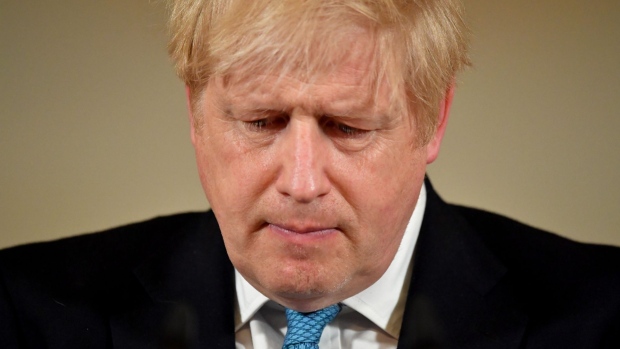Apr 6, 2020
U.K. virus crisis takes dramatic turn with Boris Johnson in intensive care
, Bloomberg News

Boris Johnson’s government faces a serious crisis at the worst possible time in the coronavirus outbreak, with the prime minister hospitalized and ministers under pressure to solve a medical equipment shortage just as Covid-19 infections approach their expected peak.
The 55-year-old prime minister was taken to the hospital on Sunday night for routine tests after struggling to shake off the virus, but his condition worsened during Monday afternoon. The pound fell after the government announced he had been moved to a facility for the most seriously ill patients.
The prime minister’s deteriorating health intensifies the difficulties facing the country as it prepares for cases to increase over the next 10 days. More than 5,000 people have died, and the nation remains in lock down. Meanwhile, the government is falling short of its target to supply hospitals with ventilators, and the influential British Medical Association said many doctors are operating without necessary protective equipment.
“Over two-thirds of doctors saying they don’t feel safely protected from Covid-19 where they work,” the BMA said in a tweet announcing the findings of its survey.
Johnson was receiving oxygen treatment at St Thomas’ Hospital in London to help his breathing, but was conscious and not on a ventilator, officials said. The prime minister has not been intubated and received less oxygen than normally required by patients in intensive care, The Times of London reported, citing sources at the hospital.
There was no change to his condition overnight, according to a person with knowledge of the matter. Foreign Secretary Dominic Raab is now deputizing for Johnson.
“There’s an incredibly strong team spirit behind the prime minister -- and making sure that we get all of the plans the prime minister’s instructed us to deliver, to get them implemented as soon as possible,” Raab said in a pooled television interview on Monday.
Adding to the government’s woes, Cabinet Minister Michael Gove -- a key member of Johnson’s top team -- said he is in self-isolation after a family member displayed symptoms of coronavirus at the weekend. Gove has no symptoms himself and is continuing to work, he said in a posting on Twitter on Tuesday.
Raab and the rest of the Cabinet face a series of key decisions in the days ahead -- on the process for easing the national lock down, and whether restrictions on people’s movements should be lifted, extended or tightened even further.
Trump Support
It’s an extraordinary turn of events for Johnson. Just over two months ago, he was at the peak of his powers, celebrating Britain’s departure from the European Union after scoring an emphatic election victory.
U.S. President Donald Trump, a supporter of Johnson, said at a press briefing that he’d told pharmaceutical companies to get in touch with London to offer help. Trump cited “rather complex” therapeutic treatments for the virus with “really incredible results,” but didn’t specify them.
“When you get brought into intensive care, that gets very, very serious with this particular disease,” Trump said.
With Johnson out of action, the untested Raab will now need to get a grip on the government machine and coordinate the pandemic response. Britain’s strategy for defeating coronavirus has already come under strain, with ministers accepting they had not done enough to test people for infections.
Johnson himself was criticized by medical experts and members of his own Conservative Party for failing to act quickly enough to close schools and ban public gatherings.
Cabinet Divisions
There have been divisions among Johnson’s officials during his period of isolation already, a situation that risks getting worse with Raab, who was a leadership rival to Johnson last year, now in charge. Gove and Health Secretary Matt Hancock also stood against Johnson for the leadership and are now in lead roles in the virus strategy.
On Tuesday, Gove told the BBC the government is working “in a team way” and taking decisions “completely by consensus,” as Raab chairs key meetings. “Physically, Boris is full of life and fit -- he is a keen tennis player and runner and he’s a man of great zest and appetite for life,” Gove told LBC radio later. “We hope and pray that he enjoys a quick recovery.”
Johnson revealed on March 27 he had tested positive for coronavirus and was going into isolation in his Downing Street apartment. His meals and official papers were left outside his door, but he continued to chair daily crisis meetings via video link.
The premier recorded several “selfie” video messages for social media in recent days in which he insisted he was doing well and remained in charge. At times, though, he appeared short of breath and visibly unwell.
Throughout the day on Monday, Johnson’s officials said the prime minister remained in control of the government and was continuing to keep in touch with his team. He was “in good spirits” on Monday morning after a “comfortable” night, despite a cough and a fever, officials said.
Yet Johnson’s team gave few details when asked what had changed. Reporters raised questions over how seriously ill Johnson was after Raab disclosed that the pair had not spoken since Saturday.
The premier received well wishes from colleagues including his predecessors Theresa May and David Cameron, as well as his chief opponent, Labour Party Leader Keir Starmer. International leaders including Irish premier Leo Varadkar and President Emmanuel Macron of France also sent messages of support.
Johnson’s fiancee, Carrie Symonds, who is pregnant, also had symptoms of the virus and had been isolating.
--With assistance from Josh Wingrove, Kitty Donaldson, Joe Mayes and Alex Morales.






